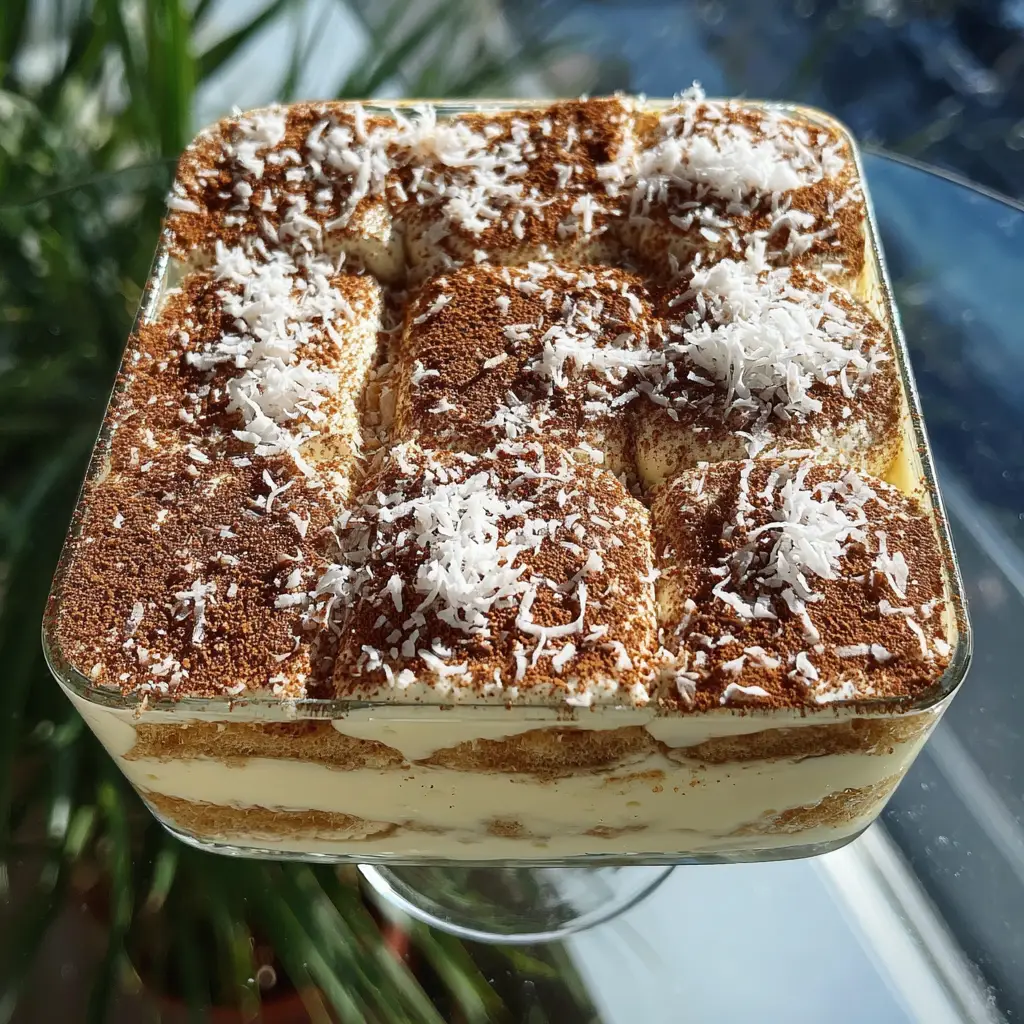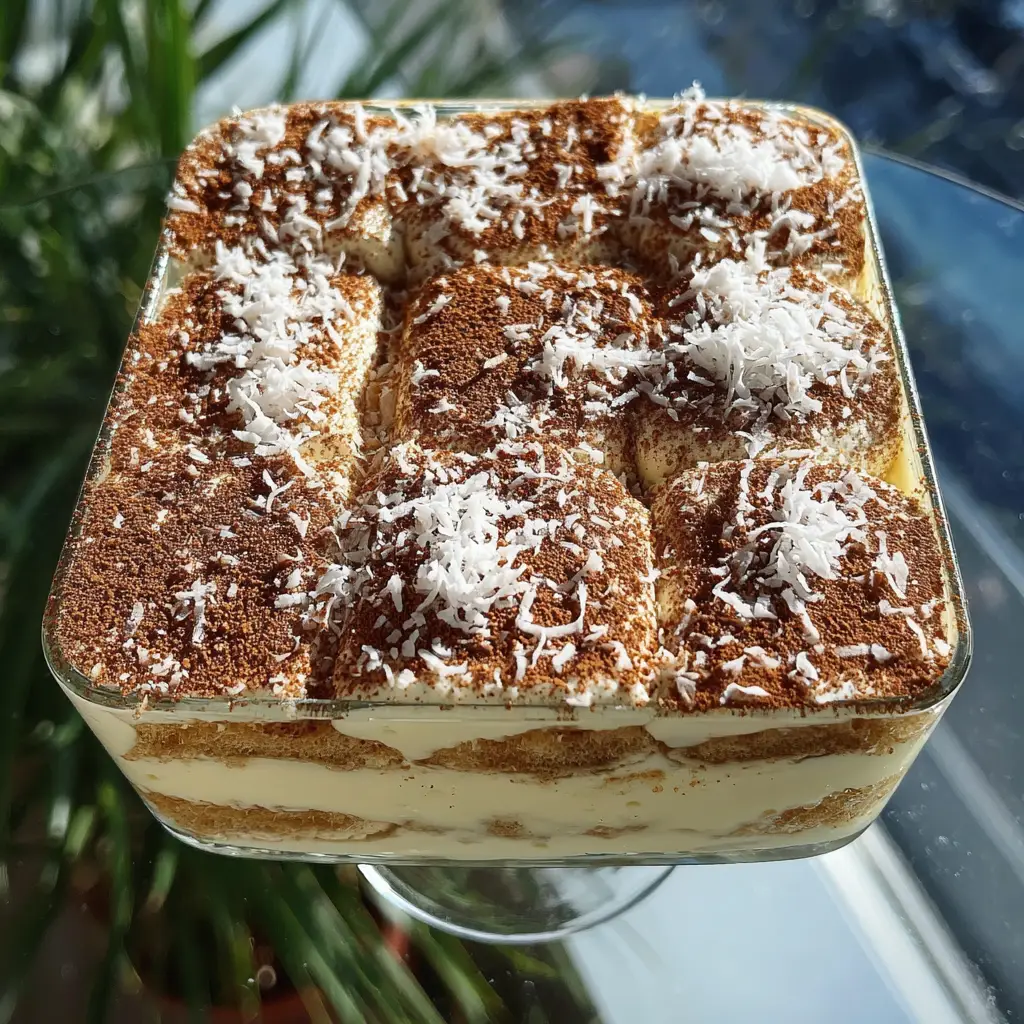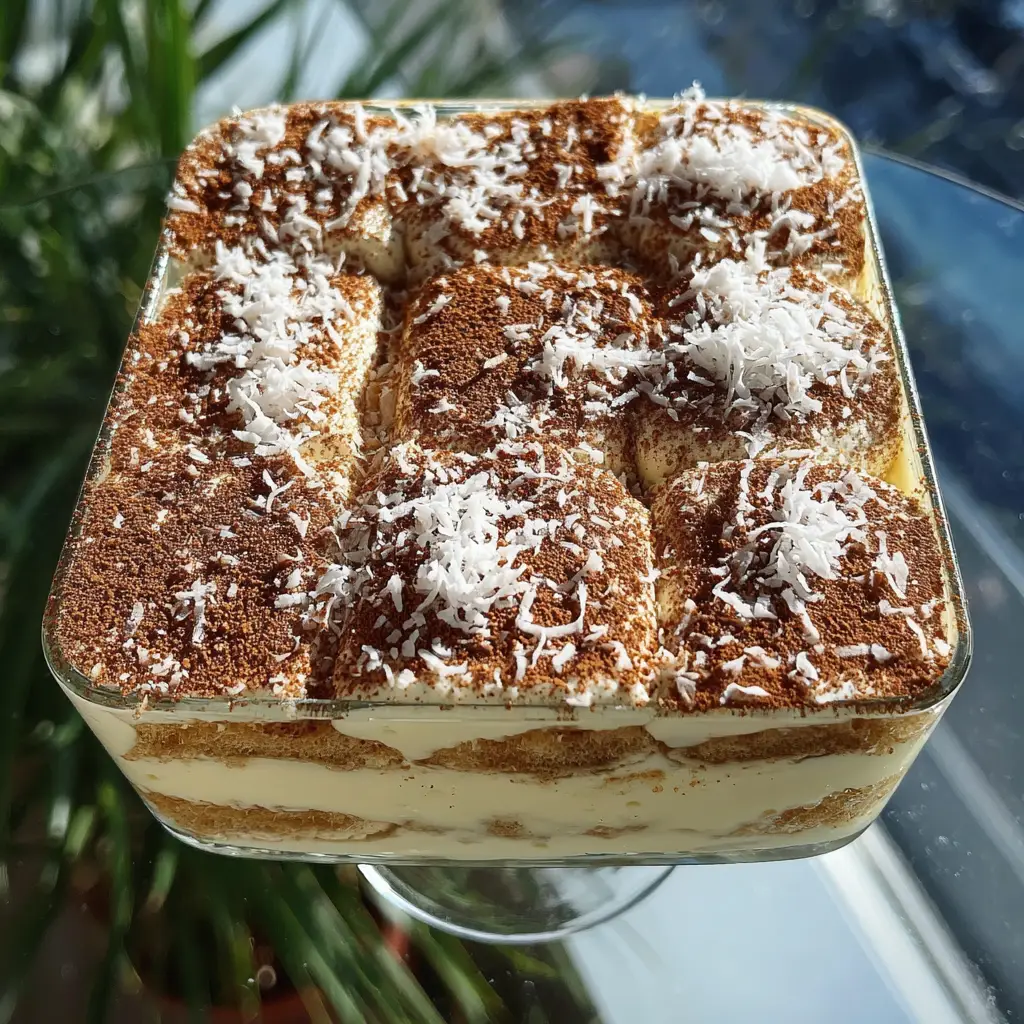| Prep Time: 30 minutes | Cook Time: N/A | Total Time: 12 hours 30 minutes | Serves: 8 |
|---|
Why Coconut Rum Coquito Tiramisu Commands Attention
The remarkable appeal of coconut rum coquito tiramisu lies in its masterful ability to bridge two beloved dessert traditions because this exceptional creation honors the time-tested technique of traditional tiramisu while embracing the vibrant, celebratory spirit of coquito that has been warming hearts during Caribbean holidays for generations. Unlike conventional tiramisu that relies solely on coffee and cocoa for its distinctive character, this tropical variation introduces layers of complexity through coconut cream, rum, and aromatic spices that create a more nuanced and exotic flavor profile that appeals to adventurous dessert enthusiasts seeking something truly special.
The cultural significance of this fusion dessert extends beyond mere ingredient substitution because it represents the beautiful evolution of classic recipes that occurs when different culinary traditions meet and inspire each other to create something entirely new yet respectful of both origins. The coquito element brings the joyful tradition of Puerto Rican Christmas celebrations, where families gather to share this beloved coconut-based beverage that symbolizes warmth, hospitality, and festive togetherness, while the tiramisu foundation provides the sophisticated structure and creamy indulgence that Italian dessert mastery is famous for worldwide.
What makes this coconut rum coquito tiramisu particularly compelling for modern home bakers is its impressive visual presentation and make-ahead convenience because the striking layers create an elegant appearance that photographs beautifully for special occasions, while the overnight chilling requirement means you can prepare this stunning dessert entirely in advance, allowing the flavors to meld and intensify while freeing up your time to focus on other aspects of your dinner party or celebration.
Essential Ingredients for Coconut Rum Coquito Tiramisu Excellence
Creating the perfect coconut rum coquito tiramisu requires carefully selected ingredients that work harmoniously to achieve the ideal balance of tropical sweetness, creamy richness, and subtle rum warmth because each component plays a crucial role in building the complex flavor layers that make this dessert so memorable and sophisticated.
Mascarpone Cheese – 16 ounces of high-quality mascarpone provides the essential creamy foundation that gives tiramisu its signature smooth texture because this Italian cream cheese offers the perfect richness and mild flavor that allows the coconut and rum elements to shine without competing flavors overwhelming the delicate balance.
Heavy Whipping Cream – 1 cup of cold heavy cream creates the light, airy texture that prevents the dessert from becoming too dense because properly whipped cream incorporated into the mascarpone mixture ensures that each spoonful delivers the perfect balance of richness and lightness that defines exceptional tiramisu.
Sweetened Condensed Milk – 1 can (14 ounces) of sweetened condensed milk provides the authentic coquito sweetness and contributes to the creamy consistency because this ingredient is essential to traditional coquito recipes and brings the characteristic sweetness that balances the rum and coconut flavors perfectly.
Coconut Milk – 1 can (13.5 ounces) of full-fat coconut milk delivers the tropical essence and rich coconut flavor because using full-fat coconut milk ensures maximum flavor impact and contributes to the luxurious mouthfeel that makes each bite indulgent and satisfying.
Cream of Coconut – 1 can (15 ounces) of cream of coconut intensifies the coconut flavor profile and adds essential sweetness because this concentrated coconut product provides more intense flavor than regular coconut milk while contributing to the authentic coquito taste experience.
White Rum – 1/2 cup of quality white rum brings the essential Caribbean spirit and warmth because rum is the defining alcoholic component of coquito, and white rum provides clean flavor that complements rather than overwhelms the delicate coconut and cream elements.
Large Egg Yolks – 5 large egg yolks create the traditional sabayon base that provides richness and helps bind the cream mixture because properly prepared egg yolks add luxurious texture and stability to prevent the cream from separating during the chilling process.
Powdered Sugar – 1/4 cup of powdered sugar sweetens the egg yolk mixture and contributes to the smooth texture because powdered sugar dissolves more easily than granulated sugar and prevents grittiness in the final product.
Ladyfinger Cookies – 2 packages (7 ounces each) of high-quality ladyfingers provide the essential structure and coffee shop authenticity because these Italian cookies are specifically designed to absorb liquid while maintaining their shape and providing the classic tiramisu texture.
Vanilla Extract – 2 teaspoons of pure vanilla extract enhances all the other flavors and adds aromatic depth because quality vanilla complements both the coconut and rum elements while providing the familiar comfort flavor that makes the dessert approachable.
Ground Cinnamon – 1 teaspoon of ground cinnamon provides the warm spice element essential to authentic coquito because cinnamon adds complexity and warmth that balances the cool, creamy elements while contributing to the traditional Caribbean flavor profile.
Shredded Coconut – 1 cup of sweetened shredded coconut for layering and garnish provides textural contrast and visual appeal because the coconut flakes add pleasant chewiness and reinforce the tropical theme throughout every layer of the dessert.
The Art of Creating Perfect Coconut Rum Coquito Tiramisu
Mastering the coconut rum coquito tiramisu requires understanding the delicate interplay between temperature, timing, and technique because this sophisticated dessert depends on achieving the perfect consistency in multiple components that must be combined at precisely the right moments to create the smooth, luxurious texture that defines exceptional tiramisu.
The foundation of extraordinary coconut rum coquito tiramisu begins with properly preparing the sabayon, a delicate custard made from egg yolks and sugar that requires gentle heat and constant whisking because this technique creates the silky base that distinguishes restaurant-quality tiramisu from amateur attempts that often result in grainy or separated cream mixtures. Temperature control becomes critical during this process because excessive heat will scramble the eggs, while insufficient heat prevents the mixture from thickening properly and developing the rich, velvety texture that provides the luxurious mouthfeel essential to the final product.
The mascarpone cream preparation demands equal attention to technique because over-mixing can cause the delicate cheese to become grainy, while under-mixing results in lumpy textures that compromise the smooth elegance expected from premium tiramisu. The incorporation of coconut elements requires careful balance because the additional liquids from coconut milk and cream of coconut can affect the stability of the cream mixture, and understanding how to adjust consistency ensures that your coconut rum coquito tiramisu maintains its structure throughout the chilling process.
Assembly technique plays a crucial role in achieving professional results because the soaking time for ladyfingers must be precisely controlled to ensure they absorb enough liquid to carry the coquito flavors without becoming so saturated that they lose their structural integrity and create a mushy texture that detracts from the sophisticated eating experience.
Step-by-Step Instructions for Coconut Rum Coquito Tiramisu Mastery
Follow these detailed instructions to create a coconut rum coquito tiramisu that rivals the finest desserts served in upscale restaurants because proper technique and attention to detail ensure consistent results and maximum flavor development in every luxurious layer.
Step 1: Prepare the Sabayon Base Begin by creating a double boiler using a heatproof bowl set over a pot of gently simmering water, ensuring that the bottom of the bowl does not touch the water because direct contact with the pot can create excessive heat that scrambles the eggs. Combine 5 large egg yolks with 1/4 cup powdered sugar and 1 teaspoon vanilla extract in the bowl, whisking continuously until the mixture becomes pale and slightly thickened, which typically takes 8-10 minutes of constant whisking.
Professional Tip: The sabayon is ready when it coats the back of a spoon and you can draw a line through it with your finger that holds its shape for several seconds, indicating that the eggs have been properly cooked and the mixture has reached the ideal consistency for binding with the mascarpone.
Key Points: Never allow the water to boil vigorously because excessive steam and heat can cause the eggs to curdle, and always whisk continuously to prevent the mixture from sticking to the bottom of the bowl or developing hot spots that could create lumps in your finished cream.
Step 2: Create the Coconut Mascarpone Mixture In a large mixing bowl, combine 16 ounces of room temperature mascarpone cheese with 1/2 cup of the sweetened condensed milk, whisking gently until smooth and well combined because room temperature mascarpone incorporates more easily and creates a smoother final texture. In a separate bowl, whip 1 cup of cold heavy cream to soft peaks, being careful not to overwhip because over-whipped cream can become grainy and affect the smooth texture of your finished tiramisu.
Professional Tip: Chill your mixing bowl and beaters in the freezer for 15 minutes before whipping the cream because cold equipment helps the cream whip faster and achieve better volume, resulting in lighter, more stable peaks that maintain their structure when folded into the mascarpone mixture.
Key Points: The mascarpone should be completely smooth before adding other ingredients, and any lumps should be whisked out thoroughly because these imperfections will be noticeable in the final dessert and detract from the professional appearance and luxurious mouthfeel.
Step 3: Combine the Sabayon and Mascarpone Remove the sabayon from the heat and allow it to cool for 2-3 minutes, then gradually fold it into the mascarpone mixture using a gentle folding motion because aggressive mixing can deflate the delicate structure and create a dense final product. Once the sabayon is fully incorporated, gently fold in the whipped cream in two additions, maintaining the light, airy texture that gives tiramisu its characteristic elegance.
Professional Tip: Use a large rubber spatula and employ a folding motion that cuts down through the center of the mixture, sweeps across the bottom of the bowl, and brings the spatula up and over the surface because this technique preserves the air bubbles that create the light texture while ensuring thorough incorporation.
Key Points: The final mixture should be smooth, light, and pale in color with no streaks of unmixed ingredients visible, and it should hold its shape when spooned but still feel creamy and luxurious rather than dense or heavy.
Step 4: Prepare the Coquito Soaking Mixture In a shallow bowl, combine the remaining sweetened condensed milk with 1 can of coconut milk, 1/2 cup of cream of coconut, 1/2 cup white rum, 1 teaspoon vanilla extract, and 1/2 teaspoon ground cinnamon, whisking until completely smooth and well blended because any lumps or separation in this mixture will affect the even distribution of flavors throughout the ladyfingers.
Professional Tip: Taste the soaking mixture and adjust the rum content to your preference because some guests may prefer a more subtle alcohol flavor, while others enjoy a stronger rum presence, and this is your opportunity to customize the intensity before assembly.
Key Points: The mixture should be smooth and aromatic with a balanced sweetness that complements rather than overwhelms the delicate mascarpone layers, and all ingredients should be completely dissolved and incorporated to prevent uneven flavor distribution.
Step 5: Begin Assembly Process Working quickly but carefully, dip each ladyfinger into the coquito mixture for exactly 2-3 seconds, turning once to ensure even absorption without allowing the cookies to become overly saturated because properly soaked ladyfingers should be moist but still maintain some structural integrity. Arrange the soaked cookies in a single layer in the bottom of a 9×13 inch glass baking dish, fitting them snugly together without overlapping.
Professional Tip: Keep a clean kitchen towel nearby to quickly wipe your hands between dipping cookies because the mixture can become sticky and make handling subsequent ladyfingers difficult, and clean hands ensure better control during the assembly process.
Key Points: Each ladyfinger should absorb enough liquid to carry the coquito flavors without becoming so soft that it falls apart, and the bottom layer should be complete and even before proceeding to add the cream mixture.
Step 6: Layer the Cream and Complete Assembly Spread half of the coconut mascarpone mixture evenly over the first layer of soaked ladyfingers, using an offset spatula to create smooth, even coverage that reaches all corners of the dish because uneven layers create an unprofessional appearance and affect the balance of flavors in each serving. Sprinkle 1/2 cup of shredded coconut evenly over the cream layer, then repeat the process with remaining ladyfingers, cream mixture, and coconut.
Professional Tip: Gently tap the assembled dish on the counter a few times to settle the layers and eliminate air pockets that could create gaps or uneven texture, but avoid vigorous shaking that could disturb the careful layering you’ve created.
Key Points: The final layer should be smooth and attractive with an even distribution of shredded coconut that provides visual appeal and textural contrast, and all layers should be clearly defined and evenly distributed throughout the dish.
Professional Tips for Coconut Rum Coquito Tiramisu Excellence
Elevating your coconut rum coquito tiramisu from homemade to restaurant-quality requires attention to professional techniques and insider knowledge that experienced pastry chefs use to ensure consistent results and exceptional flavor development because these refined methods can transform your kitchen into a destination for extraordinary desserts.
Temperature management extends beyond basic chilling because understanding how different components react to temperature changes allows you to control texture and flavor development throughout the preparation and serving process. Store your mascarpone at room temperature for at least one hour before use because cold mascarpone is difficult to mix smoothly and can create lumps that are nearly impossible to eliminate once incorporated into the cream mixture, while room temperature cheese blends effortlessly and creates the silky texture that defines exceptional tiramisu.
Quality ingredient selection significantly impacts the final result because coconut rum coquito tiramisu relies heavily on the natural flavors of its components, making premium ingredients essential for achieving the complex, nuanced taste that distinguishes memorable desserts from ordinary ones. Choose mascarpone from reputable Italian producers when possible because authentic mascarpone has a distinctly creamy texture and mild, sweet flavor that allows the coconut and rum elements to shine, while lower-quality substitutes can introduce unwanted tanginess or grittiness that detracts from the sophisticated flavor profile.
Timing coordination becomes crucial when preparing multiple components because each element must be ready at precisely the right moment to ensure proper incorporation and prevent temperature-related problems that can compromise texture and stability. Prepare your sabayon first because it needs time to cool slightly before incorporation, while the whipped cream should be prepared immediately before use because it begins to deflate and lose stability within minutes of reaching peak volume.
Creative Variations to Explore
The versatility of coconut rum coquito tiramisu allows for numerous creative adaptations that cater to different preferences and seasonal availability because experimenting with alternative ingredients and presentation styles can yield exciting new variations while maintaining the essential character that makes this dessert so appealing to sophisticated palates.
Dark Rum Coquito Tiramisu substitutes dark rum for white rum to create a richer, more complex flavor profile because aged rum provides deeper caramel and molasses notes that complement the coconut elements while adding sophisticated warmth that appeals to guests who prefer bolder alcoholic flavors. The darker rum also creates a more visually striking contrast against the pale cream layers, resulting in a more dramatic presentation that stands out at elegant dinner parties.
Chocolate Coconut Coquito Tiramisu incorporates cocoa powder into the mascarpone mixture and adds chocolate shavings between layers because this variation bridges the gap between traditional tiramisu and tropical innovation while providing chocolate lovers with familiar comfort flavors enhanced by exotic coconut and rum elements. Consider using high-quality Dutch-process cocoa for the smoothest integration and most sophisticated chocolate flavor.
Individual Coquito Tiramisu Cups presents the same flavors in elegant individual servings using glass ramekins or wine glasses because single-serving presentations create refined dinner party experiences while allowing guests to enjoy perfectly portioned desserts that maintain their structure and visual appeal throughout the meal. This variation also allows for easier customization of alcohol content for different guests’ preferences.
Tropical Fruit Coconut Tiramisu incorporates diced mango, pineapple, or passion fruit between layers to enhance the Caribbean theme because fresh tropical fruits add bright acidity and natural sweetness that balance the rich cream while providing textural interest and visual appeal that reinforces the exotic nature of this fusion dessert.
Perfect Pairing Ideas for Your Coconut Rum Coquito Tiramisu
Creating a complete culinary experience around your coconut rum coquito tiramisu involves selecting complementary foods and beverages that enhance rather than compete with the rich, tropical flavors because thoughtful pairings can elevate your entire menu and create memorable dining moments that guests will treasure long after the meal concludes.
Caribbean-inspired appetizers provide natural companionship for coconut rum coquito tiramisu because shared cultural origins create harmonious flavor progressions that feel authentic and intentional. Consider serving plantain chips with tropical salsa, coconut shrimp with mango dipping sauce, or jerk-seasoned chicken skewers because these appetizers establish the Caribbean theme early in the meal while providing savory contrast that makes the sweet dessert even more appealing, and you can find excellent inspiration in snacks appetizers that complement tropical flavor profiles.
Light, fresh salads create perfect balance when serving rich desserts because crisp greens and bright dressings provide palate-cleansing elements that prepare guests’ taste buds for the indulgent finale. Explore creative salads that incorporate tropical fruits like mango, papaya, or coconut, dressed with lime vinaigrettes that echo the citrus notes often found in Caribbean cuisine while providing refreshing contrast to the creamy richness of your tiramisu.
Complementary beverages enhance the overall dining experience because carefully selected drinks can either provide contrast or harmony depending on your menu strategy. Consider serving refreshing beverages like coconut water cocktails, tropical fruit smoothies, or light white wines that complement the coconut and rum flavors without overwhelming the delicate balance you’ve created in your dessert masterpiece.
Discover More Culinary Adventures
Expanding your dessert repertoire beyond coconut rum coquito tiramisu opens up exciting possibilities for creating comprehensive menu themes that showcase your culinary creativity because understanding how different flavor profiles work together allows you to design memorable dining experiences that keep guests engaged throughout the entire meal progression.
Breakfast celebrations offer opportunities to extend tropical themes into morning meals, and exploring breakfast favorites provides inspiration for brunch parties where coconut flavors can be incorporated into pancakes, French toast, or tropical fruit salads that create cohesive menu experiences from morning through evening dessert service. Consider preparing coconut coffee drinks or tropical fruit parfaits that share flavor elements with your tiramisu while providing appropriate morning fare.
Savory accompaniments become essential when planning comprehensive dinner parties because well-chosen side dishes can either enhance or detract from your dessert finale, and selecting perfect sides ensures that every element of your meal works together harmoniously. Consider Caribbean-inspired rice dishes, grilled vegetables with tropical marinades, or coconut-infused side dishes that reinforce your theme without overwhelming guests before they reach your spectacular dessert.
Complementary dessert options provide backup plans and variety for guests with different preferences, and incorporating dessert recipes that share tropical themes creates cohesive dessert menus that feel intentionally planned rather than randomly assembled. Consider preparing coconut macaroons, rum cake, or tropical fruit tarts that complement your tiramisu while offering alternatives for guests who might prefer lighter or different flavor profiles.
Storage Guidelines for Optimal Results
Understanding proper storage techniques for coconut rum coquito tiramisu ensures that you can prepare this elaborate dessert in advance while maintaining optimal flavor and texture because the complex cream mixture and alcohol content require specific handling to prevent separation, flavor degradation, or food safety issues that could compromise your carefully crafted dessert.
Refrigeration requirements become critical for coconut rum coquito tiramisu because the mascarpone and egg-based components must be kept at safe temperatures while the alcohol content and dairy products require consistent chilling to maintain flavor integrity and prevent spoilage. Store the completed tiramisu in the refrigerator at 37-40°F (3-4°C) and consume within 3-4 days of preparation because the combination of dairy products and alcohol creates an environment where flavor development continues during storage, but extended storage beyond this timeframe can result in texture degradation and off-flavors.
Proper covering prevents the absorption of refrigerator odors and maintains moisture levels because coconut rum coquito tiramisu contains multiple dairy components that readily absorb surrounding flavors, and exposure to air can cause the surface to dry out and form an unappealing skin that detracts from the luxurious eating experience. Use plastic wrap pressed directly onto the surface of the tiramisu, followed by aluminum foil, to create an effective barrier against air exposure and odor contamination.
Make-ahead considerations allow for optimal flavor development because coconut rum coquito tiramisu actually improves during the first 24-48 hours of refrigeration as the flavors meld and the ladyfingers fully absorb the coquito mixture, creating more cohesive and intense flavor throughout each layer. Plan to prepare your tiramisu at least 12 hours before serving, but optimal results occur after 24 hours of chilling when all components have fully integrated and the texture has achieved perfect consistency.
The Science Behind Perfect Coconut Rum Coquito Tiramisu
Understanding the scientific principles that govern the creation of coconut rum coquito tiramisu helps you troubleshoot problems and achieve consistent results because knowledge of how proteins, fats, and alcohol interact during preparation and storage allows you to make informed adjustments that ensure success every time you prepare this sophisticated dessert.
The sabayon technique relies on controlled protein coagulation because gentle heat causes the proteins in egg yolks to unfold and create a network that traps liquid, resulting in the smooth, custard-like texture that provides richness and stability to the cream mixture. Temperature control becomes critical during this process because excessive heat causes proteins to coagulate too rapidly, creating lumps and curdled textures, while insufficient heat prevents proper thickening and leaves the mixture thin and unstable.
Alcohol interaction affects both flavor development and texture because ethanol molecules bind with fat molecules in the mascarpone and cream, creating flavor compounds that wouldn’t exist in alcohol-free versions while also affecting the freezing point and stability of the cream mixture. The rum content must be balanced carefully because too much alcohol can prevent proper setting and create a loose, unstable texture, while too little fails to provide the authentic coquito character that defines this fusion dessert.
Emulsification principles govern the successful combination of water-based and fat-based ingredients because the coconut milk, condensed milk, and mascarpone contain different ratios of water and fat that must be properly integrated to prevent separation during storage. Understanding how lecithin in egg yolks acts as a natural emulsifier explains why the sabayon technique is essential for creating stable cream mixtures that maintain their texture throughout the chilling and serving process.
Fat crystal formation affects texture development during chilling because the various fats in mascarpone, heavy cream, and coconut products have different melting points and crystallization patterns that influence the final mouthfeel and stability of the dessert. Proper temperature control during preparation and storage ensures optimal fat crystal formation that creates the smooth, luxurious texture that distinguishes professional-quality tiramisu from amateur attempts.
Troubleshooting Common Issues
Even experienced home bakers encounter challenges when preparing coconut rum coquito tiramisu because the combination of multiple techniques and temperature-sensitive ingredients requires precision, and understanding how to identify and correct common problems ensures consistent results regardless of varying kitchen conditions or ingredient quality variations.
Problem: Cream mixture appears grainy or lumpy Solution: This typically indicates that the mascarpone was too cold during mixing or that the sabayon was not properly cooled before incorporation because temperature differences can cause the fats to solidify and create textural problems. Bring the mixture to room temperature and whisk vigorously, or pass it through a fine-mesh sieve to remove lumps and create smooth consistency.
Problem: Tiramisu appears watery or fails to set properly Solution: Excessive liquid from over-soaking the ladyfingers or insufficient chilling time usually causes this issue because the cream mixture needs adequate time to firm up and the cookies need to absorb liquid without becoming oversaturated. Ensure proper soaking technique and allow at least 12 hours of chilling time, covering the surface to prevent moisture loss that can affect setting.
Problem: Layers become indistinct or muddy-looking Solution: This occurs when the cream mixture is too warm during assembly or when the ladyfingers are over-soaked and break down because temperature control and proper soaking technique are essential for maintaining clean layer definition. Always ensure the cream mixture is cool but not cold during assembly, and limit soaking time to 2-3 seconds per cookie.
Problem: Alcohol flavor is too strong or too weak Solution: Rum content affects both flavor and texture, so adjustments must be made carefully because too much alcohol prevents proper setting while too little fails to deliver authentic coquito character. Adjust rum content gradually in the soaking mixture, tasting frequently, and remember that alcohol flavors intensify during chilling as components meld together.
Problem: Surface develops an unappealing skin or crust Solution: Exposure to air during chilling causes moisture loss and oxidation that creates unappetizing surface textures because dairy products are particularly susceptible to air exposure effects. Always cover tiramisu directly with plastic wrap pressed onto the surface, followed by additional covering to create an effective barrier against air exposure.
Additional Inspiration for Caribbean-Themed Celebrations
Creating memorable Caribbean-themed parties extends beyond serving exceptional coconut rum coquito tiramisu because incorporating complementary elements throughout your event design and menu planning creates cohesive experiences that transport guests to tropical paradise while celebrating the rich culinary traditions of the Caribbean islands.
Beverage pairings become essential when hosting tropical-themed gatherings because offering multiple options that share similar flavor profiles creates harmonious drinking experiences, and you can enhance your beverage menu by exploring flavored dips marinades that can inspire creative cocktail garnishes or complementary food preparations that tie your entire menu together with consistent tropical themes and authentic Caribbean influences.
Menu expansion opportunities allow you to create comprehensive Caribbean dining experiences because understanding how different island cuisines complement each other enables you to design progressive meals that build excitement toward your spectacular dessert finale. Consider incorporating savory sides that feature tropical ingredients like plantains, yuca, or coconut-enhanced vegetables that reinforce your theme while providing satisfying accompaniments to main courses.
Presentation enhancements reflect Caribbean artistic traditions because thoughtful decoration choices like tropical flowers, colorful table linens, and authentic serving pieces create visual interest while respecting cultural significance, and these aesthetic elements enhance the overall experience of enjoying traditional Caribbean-inspired flavors and sophisticated fusion desserts that honor multiple culinary heritages.
Conclusion
The coconut rum coquito tiramisu represents more than just a creative dessert fusion because it embodies the beautiful evolution that occurs when passionate home bakers embrace culinary exploration and combine beloved traditions from different cultures to create something entirely new yet respectful of both origins. This remarkable dessert successfully bridges the sophisticated elegance of Italian pastry mastery with the warm, festive spirit of Caribbean celebration because it demonstrates how thoughtful ingredient selection and proper technique can honor multiple culinary traditions while creating memorable experiences that bring people together through shared appreciation of exceptional flavors.
Mastering the art of coconut rum coquito tiramisu preparation requires understanding the delicate balance between traditional techniques and innovative adaptation because each component must be executed with precision while allowing the unique fusion elements to shine without overwhelming the fundamental characteristics that make tiramisu such a beloved dessert worldwide. The overnight chilling requirement becomes an advantage rather than an inconvenience because this extended development time allows the complex flavors to meld and intensify, creating depth and sophistication that cannot be achieved through quick preparation methods.
Whether you’re planning an intimate dinner party with close friends or a large-scale celebration, coconut rum coquito tiramisu provides the perfect finale that demonstrates your culinary sophistication while honoring the joyful spirit of Caribbean hospitality that makes every gathering more memorable and meaningful. The make-ahead nature of this dessert allows you to spend quality time with your guests rather than laboring in the kitchen during your event, while the impressive presentation and exceptional flavors ensure that your coconut rum coquito tiramisu will become the talked-about highlight that guests request for future gatherings.
Take the time to source quality ingredients, master the essential techniques, and experiment with creative variations because the investment in learning to create exceptional coconut rum coquito tiramisu will reward you with countless opportunities to create magical dessert experiences that celebrate both culinary tradition and innovative creativity while bringing joy and satisfaction to everyone fortunate enough to share in your delicious creation.










